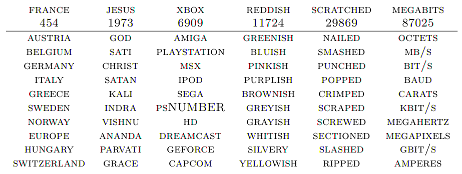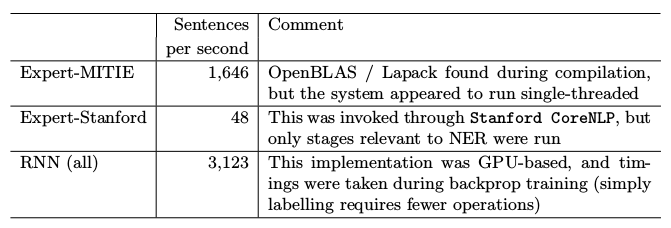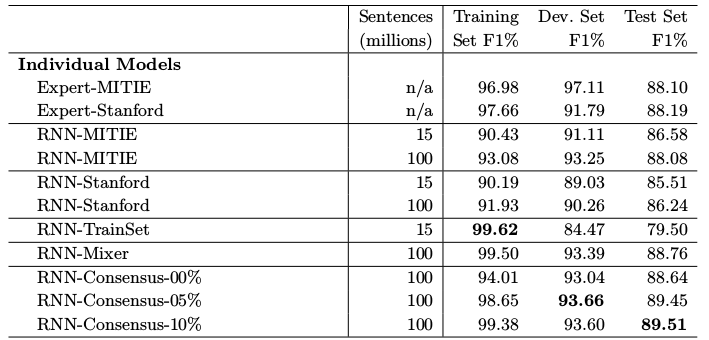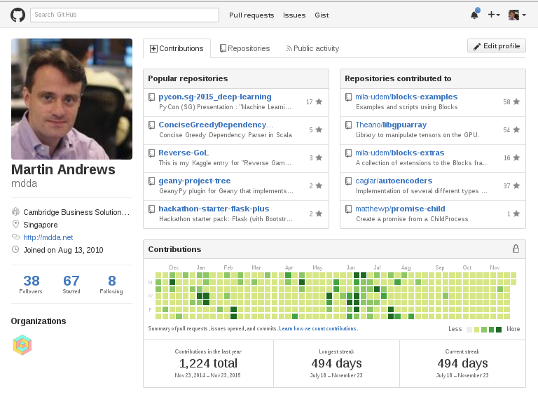Named Entity Recognition through Learning from Experts
IES-2015
Martin Andrews @ redcatlabs.com
24 November 2015
Outline
- Motivation
- Approach
- Model
- Results
- Further Work
- Conclusions
Motivation
- Building NLP system for Singapore client
- NER is an essential component
- Existing systems are not usable
NER : Quick Example
- Transform :
-
- Soon after his graduation, Jim Soon became Managing Director of Lam Soon.
- Into :
-
- Soon after his graduation,
Jim Soon PERbecame Managing Director ofLam Soon ORG.
- Soon after his graduation,
Existing Systems
- Licensing problems
- Speed problems
- Need for flexibility
Approach
- Use existing available corpus
- Use existing 'experts' ...
- ... to annotate the corpus
- Train new system on annotations
CoNLL 2003
- NER language task at the 2003 Conference on Natural Language Learning
- 16 systems 'participated'
- Top 5 F1 scores (±0.7%):
-
- 88.76%; 88.31%; 86.07%; 85.50%; 85.00%
The Experts
- For this work, used two leading NER systems:
-
- Stanford NER (part of CoreNLP)
- MITIE (from MIT)
- Other contenders:
-
- Berkeley Entity Resolution System
- Illinois Named Entity Tagger (*)
Annotate Corpus

Learn from Experts
- Build a model
- Train on annotations
- Throw away experts
- Use 'DeepNER' standalone
The Model
- Word Embedding
- Bi-Directional RNN
- Training Regimes
Word Embedding
- A map from
"token"→Float[100] - Train over corpus on windows of words
- Self-organizes...

(used word2vec)
BiDirectional RNN

BiDirectional RNN
- Python / Theano, using
blocksframework - Training runs on GPU
- Final model can run on CPU
x = tensor.matrix('tokens', dtype="int32")
x_mask = tensor.matrix('tokens_mask', dtype=floatX)
lookup = LookupTable(config.vocab_size, config.embedding_dim)
x_extra = tensor.tensor3('extras', dtype=floatX)
rnn = Bidirectional(
SimpleRecurrent(activation=Tanh(),
dim=config.hidden_dim,
),
)
# Need to reshape the rnn outputs to produce suitable input here...
gather = Linear(name='hidden_to_output',
input_dim = config.hidden_dim*2,
output_dim = config.labels_size,
)
Origin : Berkeley, now with industry buy-in
Training Regimes
- Typical run : 100,000,000 sentences
- Variations include :
-
- Single expert
- Multiple experts
- Original data
- Combined experts
Results
- Dataset quirks
- Labelling speed
- F1 scores
- Ensembling
Dataset Quirks
- Corpus is Reuters news over 10 month period
- Test data is just one month
-
- Huge numbers of sports scores
- Scores are very difficult to parse
Labelling speed

F1 Scores on CoNLL 2003

Ensemble F1 Scores

Further Work
- Implement on ASEAN-specific corpus
-
- Company-internal...
- Per-letter NER using RNN
Conclusions
- Really works...
- This is a Deep Learning system that :
-
- Exceeds capabilities of teachers
- Executes faster
- Technique means that secret sauce is data
- QUESTIONS -
Martin.Andrews @
RedCatLabs.com
My blog : http://mdda.net/
GitHub : mdda
- BLANK -
Open Source
- Compare :
-
- "Open Source is great because it costs nothing"
- "Scientific research is great because it costs nothing"
- Open Source is Big-F Free
-
- The F is for Freedom
- Everyone can contribute
- karma++
Your Name Here...
